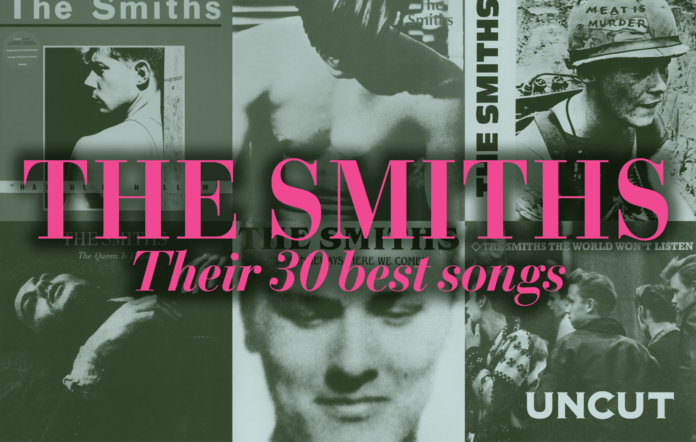1 HOW SOON IS NOW?
From the 12” of “William It Was Really Nothing” (August 1984). Re-released as a single February 1985. Highest chart position: 24
This was their most brazenly rock moment to date – a swampy, queasy Bo Diddley beat, engulfed by a crashing wave of reverbed slide, while Morrissey ditched the quips and cut to the quick: “I am human and I need to be loved, just like everybody else does”. The profligate genius of The Smiths was such that they initially considered it worthy only of B-side status.
PETER BUCK, REM: The lyrics are great, but for me, I approach it as a musical thing. If nothing else, all the guitar tones are just so wonderful. There’s the tremolo and then the slide has this amazing texture. It’s a great ensemble piece, with the four musicians all playing together really well. It’s so evocative and so kind of eerie. “How Soon Is Now?” is very un-Smiths-like.
I bought it in America, where it was the B-side to a single, though I can’t remember which [actually a double A-side with “Shakespeare’s Sister”]. That was in the days when you’d buy the single just to hear the B-side, because they were so special. I heard Seymour Stein call it “the ‘Stairway To Heaven’ of the ’80s”, but I like it better than that. “Stairway…” was played on radio stations in Georgia 10 times a day, but “How Soon Is Now?” was greatly underplayed. I don’t think I ever heard it on the radio.
Johnny and I share influences, which come out in a very melodic way. I met Johnny about a year ago, and we were hanging around together. And we started talking about The Smiths. I said, “Sure, I always loved The Smiths, but I can’t tell you how much I resented being compared to you all the time!” I’d come to England and everyone would say that I’d obviously learned everything from Johnny Marr. And I’d point out that REM had two albums out before The Smiths had released their first one, so it would have been really hard for him to influence me. And then Johnny would say: “My God, you should have seen what it was like for me when I went to America! They’d say the same thing about you!”
I followed The Smiths’ career very closely. Both REM and The Smiths put out a record every single year and played a bunch of dates. It was great, because if we had a record out, they would always put something out a couple of months later. It felt, in our own small way, what it must have been like to be The Beatles and the Stones. We’d say: “I wonder what those Smiths guys are up to?” We’d all take their records home. I remember once bumping into [Smiths producer] Stephen Street and he said: “Oh, it was exactly the same with us. We’d take REM records home with us to see where you guys had gotten to.”
These days, I see more of the legacy of The Smiths in America than in Britain. The world that Morrissey painted – lyrically – was so far removed from the American experience that it was kind of magical.
“It’s our most enduring record” – Johnny Marr on “How Soon Is Now?”
People say “How Soon Is Now?” isn’t a typical Smiths song, but neither was something like “Sweet And Tender Hooligan”. It all depends what period you’re talking about. Some people say “This Charming Man” and “Heaven Knows I’m Miserable Now”, while others say “Back To The Old House” or “This Night Has Opened My Eyes”. But I know “How Soon Is Now?” tends to stand apart. We were trying to evolve all the time. I remember I left the studio around seven in the morning when we’d finished recording it. And in the cab on the way back to my flat in Earls Court, I remember thinking we’d really gone somewhere with that song. I was spinning out.
I wrote it in that flat. I’d just done “William…” and “Please Please Please…” and needed another song for the extra track. I think the working title of “Please Please Please…” was “The Irish Waltz”, while “How Soon Is Now?” was originally called “Swamp”. And because, musically, the A-side and B-side of the single were very contrasting, I gave myself some freedom to see what I could come up with for the third tune. I could kick back a bit, which probably explains why “How Soon Is Now?” is the way it is. There’s a lot of space in it. If you think of it in context – having spent Friday and Saturday writing the other two – it gave me that freedom. I’d written “William…” in the van on the way down to London after we’d just played [Manchester’s] Free Trade Hall. Putting those three songs together was a real creative blast.
In my usual lateral way of explaining things, I was trying to get a Creedence Clearwater Revival vibe on “How Soon Is Now?”. I was a fan of The Gun Club, and their version of [Creedence’s] “Run Through The Jungle” turned me on to the idea of a long, expansive track with a groove, but that still rocked. This concept of trying to do something that was still rock, but with the chord changes not coming too quickly. It wasn’t a groove in a traditional sense.
Somewhere along the line, right from being a teenager, I’d wanted to put a tremolo riff on somewhere. The genesis of it really goes back to when I was a kid and being obsessed with “Disco Stomp” by Hamilton Bohannon [a Top 10 hit in 1975]. It doesn’t really have tremolo on it, but it’s propelled by a certain kind of rhythm playing that took up all my time for a couple of weeks.
I also liked “I Want More” by Can, but hadn’t thought about its influence until probably five seconds after I’d put the tremolo on. It was more of a sub-conscious thing. I’d used tremolo before, but I’d never used it in such a rhythmical way. I’d used it on “Wonderful Woman” and a couple of other songs. But for “How Soon Is Now?” the tremolo is the original rhythm guitar part put through four Fender Twin Reverb amps.
With the slide part, my demo had the figure on it. But it was more major key and a little more daytime and prettier. By the time I came to put it on in the studio at three in the morning – and we started to build it – it seemed appropriate to make it more intense. That was the atmosphere and that’s where I was at in that moment in time. It sounded cooler, really. [Producer] John Porter and I just followed our noses. I knew we’d nailed it the first time we played it back. It took about an hour to do it. We were pretty focused. And we were all stoned on that session. It would have been unusual for us not to be.
“How Soon Is Now?” was originally a B-side, but it was the first time in our career that the choice of an extra track seemed unduly generous. We prided ourselves on recording B-sides and extra tracks that were as strong in their own way – if not as commercial – as the A-side. But when we’d done “How Soon Is Now?”, we knew it was something else. There was definitely a debate over what we should do with it. When we’d mixed it, I remember [Rough Trade boss] Geoff Travis coming down to the studio. My recollection is that he wasn’t that into it. There was definitely negativity about it. I remember having to defend it a few times to the label – the indie police. We were aware that it was a very weighty track, but by that time, we had our heads around all aspects of the release and that “William…” was the A-side.
Where does “How Soon Is Now?” stand in The Smiths’ career? It’s possibly our most enduring record. It’s most people’s favourite, I think. The sound is very distinctive and still holds up. I was very proud when it became an A-side in its own right. It was like the radio had been invaded by the Head Police – a bunch of heads. It is heady music, especially the intro. And it’s the guitar trick I’m still most asked about. The last time I played it was at the Manchester Evening News Arena with Andy Rourke last year. [Marr and Rourke shared a stage together for the first time in 19 years in January 2006]. And the new Healers do a really good job of it. I know Morrissey still does it live, too. But TATU’s version was just silly. Plastic music.
It’s hard to speculate on The Smiths’ legacy. We were just doing what came naturally, with full-on, passionate intensity. I think it was all more accident than design, or a little of both. But all bands that stand the test of time have a certain chemistry. Ours was peculiar and unique.



